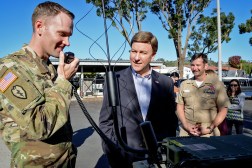Pentagon taking long-term view of STEM recruitment
The Office of Personnel Management has granted new authorities to the Defense Department that allow the Pentagon to hire up to 3,000 permanent or temporary civilian workers who possess “unique cybersecurity skills and knowledge,” according to a notice published Wednesday by OPM.
The move is part of a larger effort by the Pentagon to move forward with an aggressive recruitment and staffing campaign to beef up its planned cyber forces to defend U.S. military networks and to conduct offensive cyber warfare operations during times of conflict. The Pentagon’s strategy calls for 6,200 cyber warriors spread across 133 teams. Dozens of teams are now operating or are in the process of forming, according to Adm. Michael Rogers, commander of U.S. Cyber Command, who testified late Wednesday in front of the House Armed Services Committee.
But Rogers acknowledged to lawmakers that the military is already “hard pressed” to find qualified personnel to put on these teams. Even the Army, which has made significant progress staffing 25 of its 41 planned cyber mission teams and is establishing a cyber career field for civilian personnel to streamline hiring, will not have all of its teams ready until 2017 and will need to increase the number of support personnel required to support these teams and the infrastructure.
Although the urgency of the situation has taken center stage for the time being, behind the scenes senior military officers are thinking about the long-term requirements of maintaining a steady stream of skilled cybersecurity personnel in uniform and in civilian support roles. And that effort has led them not only to local communities and high schools — where military recruiters are normally found — but even to kids as young as elementary school age.
Rep. Joaquin Castro, D-Texas, even raised the idea of adjusting the language in the education reauthorization bill now before Congress to ensure public school educational programs are preparing “more students to take on roles in cybersecurity” and ensure that the military “has a pipeline of qualified people who can take on these jobs.”
“You’ve got to get young folks excited about cybersecurity,” said Air Force Maj. Gen. Burke Wilson, commander of the Air Force Cyber Command. “What we found is that they yearn for interaction with people who are really doing the job.”
The most successful community programs being run by the Air Force include the CyberPatriot initiative, an effort sponsored by the U.S. Air Force Association that allows Air Force members to mentor students in a nationwide cybersecurity competition involving more than 9,000 middle school and high school students.
Another program, known as “Troops for Teens,” is focused on reaching more than 100 at-risk high school students through exposure to military values, heritage and way of life, Wilson said.
“When we’re able to interact with the schools at the grassroots level it seems to be the most effective,” Wilson said. But more mentors are needed, he said.

Cyber professionals from 24th Air Force volunteered to mentor teens, Nov. 19, in the Troops for Teens program, a partnership between 24th Air Force and South San Antonio Independent School District designed to offer tutoring and mentorship to high school teens. (Senior Master Sgt. Dorian Chapman/Air Force)
The national average for kids interested in science, technology, engineering and mathematics, or STEM, fields is below 15 percent. “We’re seeing those numbers when kids come in, but we’re seeing graduates out of CyberPatriot at the 80 to 85 percent rate who are interested in cybersecurity or STEM degrees when they go off to college,” Wilson said. “When you look at the caliber and the content of what they know when they walk in the door, they don’t know a lot about cybersecurity, but when they walk out they know a lot about it. And so it’s getting them motivated. I think they can see themselves in those career fields.”
But this year the program saw a 40 percent increase in enrollment. The biggest reason for the jump? “Because we got into the middle schools,” Wilson said. “Next year, we’re going to take a stab at the upper tiers of the elementary schools.
Even Rogers is getting into the recruiting and educational partnership act, visiting a charter school Tuesday in New York’s Harlem district. “I remind them, you are educating our workforce,” Rogers said. “I have a vested interest in partnering with you to help us do that.”






